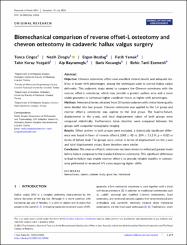| dc.contributor.author | Cingöz, Tunca | |
| dc.contributor.author | Ziroğlu, Nezih | |
| dc.contributor.author | Bozdağ, Ergün | |
| dc.contributor.author | Yamak, Fatih | |
| dc.contributor.author | Yozgatlı, Tahir Koray | |
| dc.contributor.author | Bayramoğlu, Alp | |
| dc.contributor.author | Kocaoğlu, Barış | |
| dc.contributor.author | Esemenli, Behiç Tanıl | |
| dc.date.accessioned | 2024-08-04T07:24:21Z | |
| dc.date.available | 2024-08-04T07:24:21Z | |
| dc.date.issued | 2024 | en_US |
| dc.identifier.citation | Cingöz, T.; Ziroğlu, N.; Bozdağ, E.; Yamak, F.; Yozgatlı, T. K.; Bayramoğlu, A.; Kocaoğlu, B.; Esemenli, B. T. Biomechanical comparison of reverse offset-L osteotomy and chevron osteotomy in cadaveric hallux valgus surgery (2024). Journal of Foot and Ankle Research, 17(3): 1-9. | en_US |
| dc.identifier.issn | 1757-1146 | |
| dc.identifier.uri | https://doi.org/10.1002/jfa2.12046 | |
| dc.identifier.uri | https://onlinelibrary.wiley.com/doi/10.1002/jfa2.12046 | |
| dc.identifier.uri | https://hdl.handle.net/20.500.12780/873 | |
| dc.description.abstract | Objective: Chevron osteotomy offers near-excellent clinical results and adequate stability at lower shift percentages, among the techniques used to correct hallux valgus deformity. This cadaveric study aimed to compare the Chevron osteotomy with the reverse offset-L osteotomy, which may provide a greater surface area and a more stable geometry to withstand higher cantilever forces at higher shift percentages. Methods: Metatarsal bones obtained from 20 human cadavers with similar bone quality were divided into two groups: Chevron osteotomy was applied to the 1st group and reverse offset-L osteotomy was applied to the 2nd group. The load-to-failure, displacement in the y-axis, and total displacement values of both groups were compared statistically. Furthermore, bone densities were compared between the groups with computed tomography imaging. Results: When outliers in both groups were excluded, a statistically significant difference was found in favor of reverse offset-L (143 ± 42 vs. 204 ± 51.2 N, p = 0.02) in terms of failure load. The groups were similar in terms of displacement on the y-axis and total displacement values. Bone densities were similar. Conclusion: The reverse offset-L osteotomy has been shown to withstand greater loads before failure compared to the standard Chevron osteotomy. This significant difference in load-to-failure may enable reverse offset-L to provide reliable stability in osteotomies performed in advanced HV cases requiring higher shifts. | en_US |
| dc.language.iso | eng | en_US |
| dc.publisher | John Wiley and Sons Inc | en_US |
| dc.relation.isversionof | 10.1002/jfa2.12046 | en_US |
| dc.rights | info:eu-repo/semantics/openAccess | en_US |
| dc.subject | Biomechanics | en_US |
| dc.subject | Bunion | en_US |
| dc.subject | Cadaver study | en_US |
| dc.subject | Great toe | en_US |
| dc.subject | Metatarsal | en_US |
| dc.title | Biomechanical comparison of reverse offset-L osteotomy and chevron osteotomy in cadaveric hallux valgus surgery | en_US |
| dc.type | article | en_US |
| dc.contributor.department | İstanbul Kent Üniversitesi, Fakülteler, Sağlık Bilimleri Fakültesi, Fizyoterapi ve Rehabilitasyon Bölümü | en_US |
| dc.contributor.authorID | https://orcid.org/0000-0002-0363-5939 | en_US |
| dc.contributor.institutionauthor | Esemenli, Behiç Tanıl | |
| dc.identifier.volume | 17 | en_US |
| dc.identifier.issue | 3 | en_US |
| dc.identifier.startpage | 1 | en_US |
| dc.identifier.endpage | 9 | en_US |
| dc.relation.journal | Journal of Foot and Ankle Research | en_US |
| dc.relation.publicationcategory | Makale - Uluslararası Hakemli Dergi - Kurum Öğretim Elemanı | en_US |


















